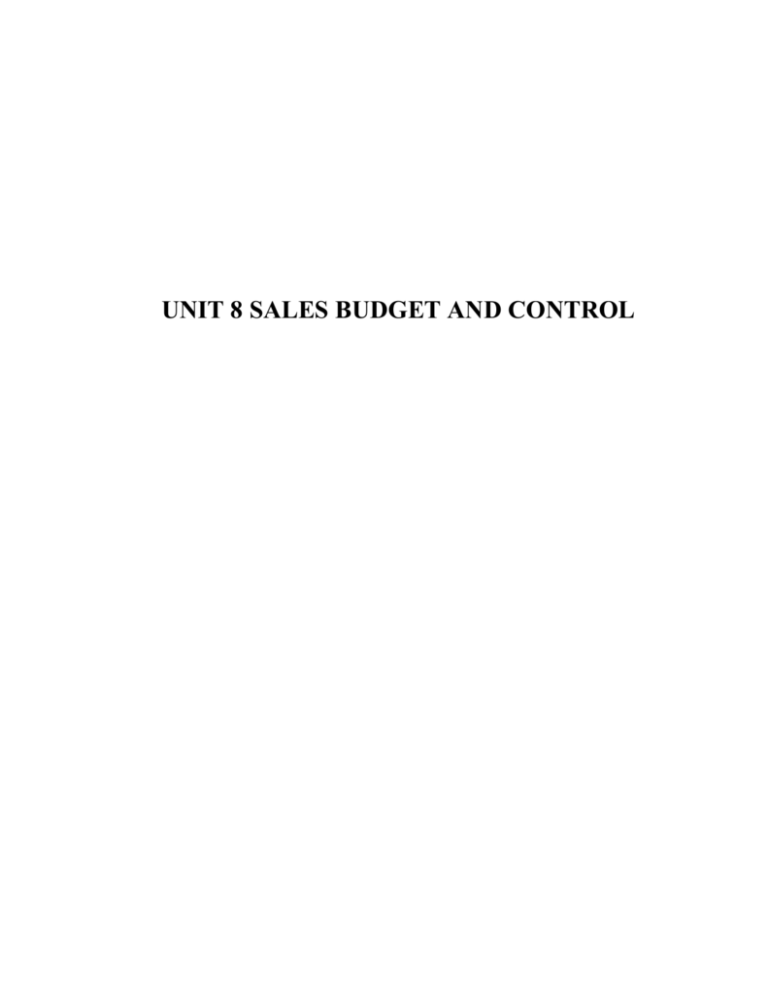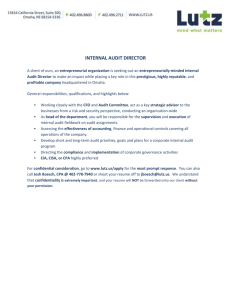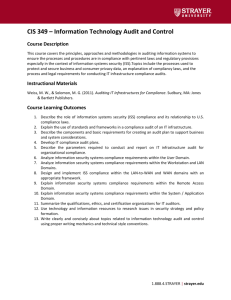
UNIT 8 SALES BUDGET AND CONTROL
Sales Budget and Control
UNIT 8 SALES BUDGET AND
CONTROL
NOTES
Structure
8.0
8.1
8.2
8.3
8.4
8.5
Introduction
Unit Objectives
What is a Sales Budget?
The Budgeting Process
Methods of Sales Budgeting
Preparing the Sales Budget
8.5.1 Review and Analysis of the Marketing Environment
8.6 Sales Control
8.6.1 Purpose of Sales Control
8.6.2 The Sales Control System
8.7 Nature of Control
8.7.1 Methods of Sales Control
8.8
8.9
8.10
8.11
Summary
Key Terms
Answers to ‘Check Your Progress’
Questions and Exercises
8.0 INTRODUCTION
Sales budgets and control help to monitor sales performance. They also help to maintain
and improve the efficiency of sales operations. This unit helps to understand the use of
a sales budget and the ways in which a sales budget can be prepared. It also presents to
the reader the the various processes and methods that go into sales control.
8.1 UNIT OBJECTIVES
After going through this unit, you will be able to:
Explain how sales control helps to monitor sales performance, maintain and improve
the efficiency of sales operations
Understand the various proceses and methods of sales control
Appreciate the importance of audit
Understand the role of budget setting in order to achieve the actual sales target
Describe the various budget-setting methods
8.2 WHAT IS A SALES BUDGET?
A budget is a financial plan and tool of control. In a sales budget, resources are allocated
to achieve the sales forecast. It states what and how much each salesperson will sell.
It also spells out what and how much will be sold to the different classes of customers.
A budget is an estimate of sales, either in units or value and the selling expenses likely to
be incurred while selling.
Self-Instructional
Material
97
Sales Budget and Control
Once the budget is accepted in terms of estimated sales, expenses and profit
figures, the actual results are measured, and compared against the budgeted figures. It
is an instrument of planning that shows how to spend money to achieve the targeted
sales. A budget also anticipates a particular level of profit.
NOTES
PROMOTION
Advertising
Personal Selling
Other Promotional
Personal Selling
Objectives
Sales Related
Policies
Sales Budget
Sales Force
Management
Control
Figure 8.1 Budget in Promotion MIx
Table 8.1 Format of a Sales Budget (Quarterly)
Budgeted
Actual
December
January
Expenses
Salaries
Commissions
Bonus
Medical
Retirement
Travel
Lodging
Food (Boarding)
Entertaining
Office expenses
Mail
Telephone
Miscellaneous
Promotions
Samples
Catalogues
Pricelists
Visuals
Advertising
98
Self-Instructional
Material
Source: Professional Sales Management by Anderson, Hair and Bush (page 104).
February
Budgeting is a short-term exercise that attempts to optimise business profits by
accommodating customer-service activities and incurring expenses to acquire new
business. For instance, to increase the sales volume by Rs. 2 lakh, sales management
may have to rope in new customers. The expense of appointing new customers is also
included in the budget.
Sales Budget and Control
NOTES
A format of the sales budget can be seen in Table 8.1.
8.3
THE BUDGETING PROCESS
In many organizations, sales is the key variable for formulating the budgets of the other
departments. Thus raw materials and production are purchased and planned in
accordance with the sales estimate, leading to the purchasing budget. Finance is arranged
in accordance with the requirements of production and other departments. Human
resources are deployed to realize the overall planning requirements. The starting point
becomes the sales budget. It generates other budgets like the inventory budget, purchase
budget, production budget and so on. The sales budget becomes a major input in the
financial plan.
Planning can be top-down or bottom-up. In a top-down plan, the plan flows from
the top, and is broken down into smaller units. In a bottom-up plan, the departments and
units set their own goals, which are aggregated at the top. In sales budgeting, some
organizations adopt a top-down approach in which the goals are set by the immediate
higher level. Some organizations follow a bottom-up approach where each level in sales
right from the salesman puts forward sales and profit objectives. The bottom-up style is
more participatory.
Each budget has quotas or standards, against which management has to measure
performance. Evaluation and control are vital parts of the management process. As the
opening scenario suggests, management needs feedback on the effectiveness of its plan
and the quality of its execution to operate more effectively; otherwise it is easy to lose
sight of the firm’s objectives.
In order to achieve goals and objectives, sales managers plan by outlining the
essential costs to be incurred.
The budget acts as an instrument of coordination. Selling is one of the functions
of marketing and needs support from the elements of marketing mix. Budgets help in
integrating all functions, like sales, finance, production and purchase.
A comparison between budgeted and actual cost results in the analysis of factors
causing variations and enables the sales manager to spot problem areas or plan better
for expected outcomes.
8.4 METHODS OF SALES BUDGETING
Check Your Progress
Affordable Method: Many companies set the promotion budget at what they think the
company can afford. This method is adopted by firms dealing in capital industrial goods.
1. What is a sales
budget?
Rule of Thumb (percentage of sales) Method: Most companies set their sales budget
as a specified percentage of sales (either current or anticipated). Mass-selling goods
and companies dominated by finance are major users of this method.
2. What is the advantage
of comparing the
budgeted costs with
the actual costs?
Self-Instructional
Material
99
Sales Budget and Control
NOTES
Competitors’ Parity Method: This method is adopted by large-sized companies facing
tough competition. The knowledge of competitors’ activities and resource allocation is
important if an organization wants to pursue this method.
Objective and Task Method: This method calls upon marketers to develop their budgets
by identifying the objectives of sales function and then ascertaining the selling and related
tasks to achieve the objectives.
8.5 PREPARING THE SALES BUDGET
The sales budget is the most important element of sales. There are three basic sales
budgets, namely:
1. Sales budget: This budget is kept for sales activities.
2. Selling expense budget: This budget is basically designed for dealing with sales
expenses.
3. Sales department administrative budget: This budget is designed for expenses
related to administrative purposes.
The proforma of a sales budget is given in Table 8.2.
Table 8.2 Specimen Form of a Sales Budget
Items
Sales
Month 1
Budget
Expenditure
Salaries
Commission
Bonus
Medical treatment
Retirement
Travel
Lodging
Food
Entertainment
Office Expenses
Mail
Telephones
Miscellaneous
Promotions
Samples
Catalogue
Price list
Advertising
Control of the Sales Operation
Self-Instructional
100 Material
Actual
Month 2
Difference
Month 3
8.5.1 Review and Analysis of the Marketing Environment
District sales managers prepare their district budget and submit it to the regional or
divisional office where they are added to and included in the divisional/regional budget.
In turn, these budgets are submitted to sales managers for the particular product or
market groups. At the end of the chain of subordinate budgets, the top executives in the
sales department scan and prepare a final sales budget for the company.
Sales Budget and Control
NOTES
Resources have to be allocated to products, customers and territories. The budget
should be realistic in order to maximize its favourable impact on the firm. An analysis of
SLEPT factors is undertaken before setting the budget. SLEPT factors are social, legal,
economic political and technological factors that are present in the environment and help
in scanning the environment.
Every budget proposal submitted to top management must remain in competition
with proposals submitted by heads of other divisions.
Actual budget control features go into operation as soon as the approved budget
has been distributed to all units of the firm. Each item in the budget serves as a quota or
standard against which performance is measured.
8.6 SALES CONTROL
One of the most important responsibilities of a sales manager is to exercise control over
sales and the performance of selling/sales activities. Sales need to be controlled both on
an ongoing (continuous) basis as well as overall, periodically. The sales control function
assists the manager in ascertaining which level of sales have been achieved, why there
has been a variance and what remedial action can be taken to achieve the target results.
8.6.1
Purpose of Sales Control
Sales control assists the sales manager in:
Initiating remedial steps
Revising the sales policy and strategies followed
Implementing steps for improving the productivity of sales force
Improving the quality of target-setting sales plans and budget functions
Increasing sales profitability
8.6.2 The Sales Control System
A sales control system should be set up on the following guidelines:
1. Setting detailed objectives
2. Establishing standards for appraising performance
3. Gathering information on actual sales activities and results
4. Comparing actual with expected sales
5. Taking remedial action .
The existence of a comprehensive sales information system in the firm is a
prerequisite for an effective sales control system. This can be done by recording sales
by value, by customer, by salesperson, by territory, by distribution outlet, by cash or
credit.
Self-Instructional
Material
101
Sales Budget and Control
NOTES
8.7 NATURE OF CONTROL
The key role played by evaluation and control in the management process is depicted in
the feedback-control system shown in Figure 8.2. Company goals initiate the process by
serving as the targets that guide the formulation of plans. Once designed, the plans need
to be implemented to become part of the daily operations. The firm then needs to collect
and organize information about its operations so that it can compare this data with its
goals to determine how well it is doing. Such evaluation and comparison provide the
control for the enterprise.
Goals
Implemented
Plans
Feedback
Necessary changes
Figure 8.2 Control of the Sales Operation
Comparison between budgeted and actual cost result in the analysis of factors
causing variations and enables the sales manager to spot problem areas or plan better
for expected outcomes.
8.7.1 Methods of Sales Control
Sales volume analysis
This is a detailed examination of sales volume by territory, salesperson, customer, product
line, etc., which is recommended in order to know the real situation and gain meaningful
insight.
The sales manager scans the total sales on territory basis. Any unusual conditions
in any territory such as intense competition, strike by labour union or transportation, etc.,
which has an adverse effect on the company’s products, is considered for further sales
analysis. In the above example, actual sales need to be compared with desired sales and
the reasons for variations looked into.
Table 8.3 Sales Analysis by Product Line
Product line
Xerox machines
Portable typewriter
Fax machine
Laptop
Personal computer
Quota achieved
Actual Quota
Performance (%)
50
40
30
20
20
55
40
06
20
18
100
100
20
100
90
160
139
86.9
We see, in Table 8.3, that sales of typewriters and laptops have been achieved as
per actual quota. Here the cost incurred to achieve sales is considered. It is not just
sales but sales with budgeted profits or expenses that matter.
Self-Instructional
102 Material
Sales Budget and Control
Cost analysis technique
A cost analysis attempts to isolate the costs incurred in producing various levels of sales
in order to determine the segment-wise profitability of sales of the business. Cost analysis
can be used by sales mangers to investigate the profitability of regions, territories, customers
and various channels of distribution.
NOTES
A successful cost analysis benefits the manager in ascertaining:
The relative cost and profitability of the sales operation
Profitable, not-so-profitable and not profitable territories
The products, pack sizes, market segments, distribution channel
The minimum order level quantity
The productivity of salespersons
The profitability of different sales promotion techniques
The profitability of different marketing mix programmes
Performance analysis
This analysis is used to judge the performance of the sales representative based on five
factors:
role perception, aptitude, skill level, motivation level, personal and organizational variables
that affect performance. All these factors are linked to behaviour, performance of the
salesperson and the effectiveness in performing his duties. Behaviour refers to what
salespersons do. Performance is behaviour evaluated in terms of contributions.
Effectiveness is the outcome of the individual in the job he has to perform.
Figure 8.3 Represents the Performance Analysis Model.
Role perception
Aptitude
Behaviour-/
Performance
Effectiveness
Selling/Sales-activities
Organization goals
Skill level
Motivation level
Sales-job
Figure 8.3 Performance Analysis Model
Sales management audit
A sales management audit is a comprehensive, systematic, independent and periodic
audit of sales policy, objectives, strategies, organization and procedures followed by the
firm. The purpose of a sales management audit is to evaluate the soundness of the sales
management of the firm. It examines the validity of the very basis and assumption on
which the sales function is planned and managed. By critically evaluating the sales
management against the changing market environment, it points out the emerging areas
of opportunity as well as areas that need observation.
Self-Instructional
Material
103
Sales Budget and Control
Some aspects covered in a sales management audit are:
The appropriateness of selling functions and objectives
The role of selling function in promotional mix and sales marketing integration
NOTES
Organization and work norms of the sales force and its size
Recruitment, selection, promotion policy, compensation motivation of the sales
force
The basis of sales quota, sales budget, territory allocation and their market suitability
The quality of the sales force, appraisal criteria, training and development of sales
personnel.
Marketing audit
The most thorough mechanism for evaluating the marketing effort is a marketing audit.
A marketing audit is a complete, systematic, objective evaluation of the total marketing
effort of a firm. Marketing audits examine the firm’s goals, policies, organization, methods
and procedures, and personnel.
The two basics types of marketing audits are vertical and horizontal. The horizontal
audit is often referred to as a marketing mix audit in that it examines all the elements
that go into the marketing mix. It emphasizes the relative importance of the various
elements and the mix among them. In contrast, the vertical audit singles out selected
elements of the marketing operation and subjects them to thorough study and evaluation.
Sales report
A sales report is an instrument of control and regulation of activities of a salesperson. A
report can be a daily sales report or a weekly one. The salesperson fills the tasks and
activities of the day in the sales report. This sales report is used by sales managers to
evaluate the performance of the sales people, as well as compare the sales report with
the budget and sales target set for the salesperson by the sales organization.
8.8 SUMMARY
Sales control is a function of sales management for ensuring that operations are carried
out as per plan to achieve the sales objectives. The sales budget is a statement of
revenues and costs. It is one of the control devices available with the management
which also helps in sales planning. Thus budget and control complement each other in
the implementation of the sales programme.
8.9 KEY TERMS
Check Your Progress
Budget: It is statement of expenses for the coming financial year.
3. How is sales control
useful for a sales
manager?
Marketing mix: It refers to the four Ps of marketing, namely product, price,
place, promotion.
4. What is a sales
management audit?
Top-down approach: It is an approach in which authority directions flow from
top management downwards.
5. Define ‘sales report’.
Self-Instructional
104 Material
Bottom-up approach: It is an approach in which various decisions are taken at
local levels and communicated upwards.
Performance Analysis: It is analysis of various factors that affect the functioning
of an employee.
Sales Budget and Control
NOTES
8.10 ANSWERS TO ‘CHECK YOUR PROGRESS’
1. In a sales budget, resources are allocated to achieve the sales forecast. It states
what and how much each salesperson will sell. It also spells out what and how
much will be sold to the different classes of customers.
2. A comparison between budgeted and actual cost results in the analysis of factors
causing variations and enables the sales manager to spot problem areas or plan
better for expected outcomes.
3. Sales control assists the sales manager in:
Initiating remedial steps
Revising the sales policy and strategies followed
Implementing steps for improving the productivity of sales force
Improving the quality of target-setting sales plans and budget functions
Increasing sales profitability
4. A sales management audit is a comprehensive, systematic, independent and
periodic audit of sales policy, objectives, strategies, organization and procedures
followed by the firm.
5. A sales report is an instrument of control and regulation of activities of a
salesperson. A report can be a daily sales report or a weekly one.
8.11 QUESTIONS AND EXERCISES
Short-Answer Questions
1. Why does audit play an important role in sales management?
2. What is the role of budget-setting in achieving the actual sales target?
Long-Answer Questions
1. Explain how sales control helps to monitor sales performance and maintain and
improve the efficiency of sales operations.
2. What are the various and processes methods of sales control? Discuss.
3. What are the various budget-setting methods? Explain each in detail.
Self-Instructional
Material
105
Author: Vimi Jham
Copyright © Author, 2011
All rights reserved. No part of this publication which is material protected by this copyright notice
may be reproduced or transmitted or utilized or stored in any form or by any means now known or
hereinafter invented, electronic, digital or mechanical, including photocopying, scanning, recording
or by any information storage or retrieval system, without prior written permission from the Publisher.
Information contained in this book has been published by VIKAS® Publishing House Pvt. Ltd. and has
been obtained by its Authors from sources believed to be reliable and are correct to the best of their
knowledge. However, the Publisher, its Authors & UBS shall in no event be liable for any errors,
omissions or damages arising out of use of this information and specifically disclaim any implied
warranties or merchantability or fitness for any particular use.
Vikas® is the registered trademark of Vikas® Publishing House Pvt. Ltd.
VIKAS® PUBLISHING HOUSE PVT LTD
E-28, Sector-8, Noida - 201301 (UP)
Phone: 0120-4078900 Fax: 0120-4078999
Regd. Office: 576, Masjid Road, Jangpura, New Delhi 110 014
Website: www.vikaspublishing.com Email: helpline@vikaspublishing.com
UBS The Sampuran Prakash School of Executive Education
Gurgaon, Haryana, India
www.ubs .edu.in







